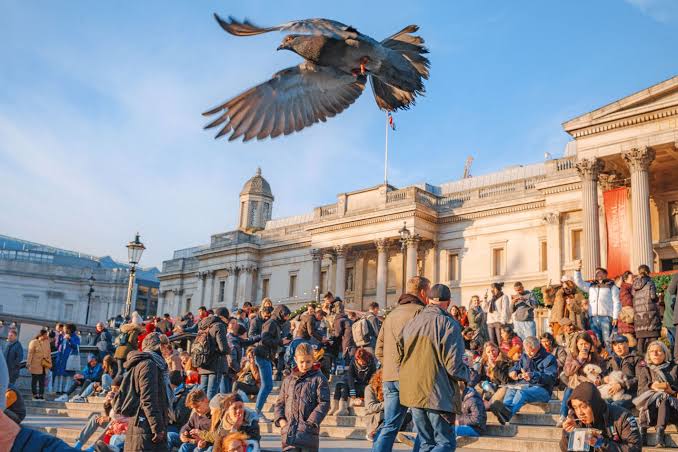 In an unexpected twist to London’s lockdown impact, the city’s iconic pigeons have seemingly begun to abandon their long-time urban territory. Known for their resilient adaptation to city life and often considered the feathered inhabitants of London’s squares, parks, and rooftops, pigeons are now reported to be migrating away from central areas. This sudden change, while initially overlooked, has sparked intrigue among ornithologists and city officials alike.
In an unexpected twist to London’s lockdown impact, the city’s iconic pigeons have seemingly begun to abandon their long-time urban territory. Known for their resilient adaptation to city life and often considered the feathered inhabitants of London’s squares, parks, and rooftops, pigeons are now reported to be migrating away from central areas. This sudden change, while initially overlooked, has sparked intrigue among ornithologists and city officials alike.
Why the Pigeons Are Leaving: The Decline of Their Food Source
Pigeons are highly adaptable birds that have relied heavily on human activity to sustain their urban existence. Typically, their diet consists of food scraps left in public places and handouts from passersby. However, the series of lockdowns brought on by the COVID-19 pandemic reduced pedestrian activity drastically, effectively cutting off the pigeons’ main food supply. With fewer people on the streets, the lack of dropped food waste and voluntary feeding has meant that pigeons have had to search further afield for sustenance.
During the pandemic, restrictions kept people at home, drastically reducing activity in tourist-heavy areas such as Trafalgar Square, Piccadilly Circus, and Hyde Park. With fewer crumbs and leftovers, pigeons began to move away from these once-prosperous feeding grounds in search of more reliable food sources.
Migration to the Suburbs and Rural Areas
As a result of these food shortages, many of London’s pigeons have been observed moving toward suburban areas and even into nearby rural settings. In these locations, food sources are often more varied, including crops, insects, and small wildlife that are generally unavailable in urban areas. Ornithologists have observed that pigeons can adapt to a rural diet when necessary, although it is not their natural preference after generations of city living.
Areas surrounding London, such as Surrey and Hertfordshire, have seen a notable increase in pigeon populations as the birds disperse from central London. Birdwatchers in these regions report seeing larger flocks and observing urban pigeons in places they were rarely seen before.
Environmental Impact and Concerns for the Pigeons’ Health
The pigeons’ departure from urban centers has also raised questions about the long-term health and survival of these birds. Many urban pigeons rely on food sources that are high in carbohydrates and fats, which they cannot find in the same quantities in rural areas. The change in diet could affect their health and reproduction patterns, as well as their overall resilience.
Additionally, suburban and rural environments come with a different set of hazards, including predators like hawks and cats, as well as the risk of being displaced by other bird species more accustomed to these regions. Urban pigeons, adapted to city life over many generations, may struggle to thrive in these new territories, leading to potential declines in their population.
Pigeons as an Unlikely London Icon
The potential disappearance of pigeons from London’s iconic landscapes has emotional and cultural implications for the city. Despite their status as common urban wildlife, pigeons have long been a familiar presence in London’s parks and streets, where tourists and locals alike have grown accustomed to their flocks. Pigeons are even immortalized in local folklore, art, and photography. For many Londoners, the pigeon is a symbol of the city’s bustling, resilient nature, representing its ability to thrive despite adversity.
Without their presence, popular areas could feel starkly different, and the city’s ecosystem may experience subtle changes. As omnivorous scavengers, pigeons play a role in managing urban waste by consuming food scraps that would otherwise require cleanup. Their departure has already led to a noticeable reduction in the city’s natural waste management, with small food remnants building up in public areas as humans gradually return to these spaces.
What’s Next for London’s Pigeons?
While the future of London’s pigeon population remains uncertain, ornithologists and city officials are studying ways to support their gradual return. Efforts may include setting up designated feeding zones in urban areas or enacting measures to improve biodiversity and provide alternative food sources in the city.
There are also considerations to create pigeon-friendly habitats in London parks, encouraging the birds to re-establish themselves in places where they are both safe and supported. However, experts caution against hasty solutions, as relying on human intervention could create an unhealthy dependency and disrupt the pigeons’ natural adaptation process.
Some researchers suggest that as human activity in London fully resumes, the pigeons may gradually return to their former urban habitats. However, it’s also possible that the pandemic will lead to a long-term reshaping of pigeon populations in London. The pigeons’ adaptive response to a changing environment is a reminder of how interconnected human activity and urban wildlife have become, even in ways often taken for granted.
As one of London’s most enduring urban animals, the story of the pigeons’ departure underscores the unforeseen impacts of the pandemic. It reveals how even subtle shifts in human behavior can ripple through ecosystems, affecting the very fabric of urban life.

Leave a Reply
You must be logged in to post a comment.